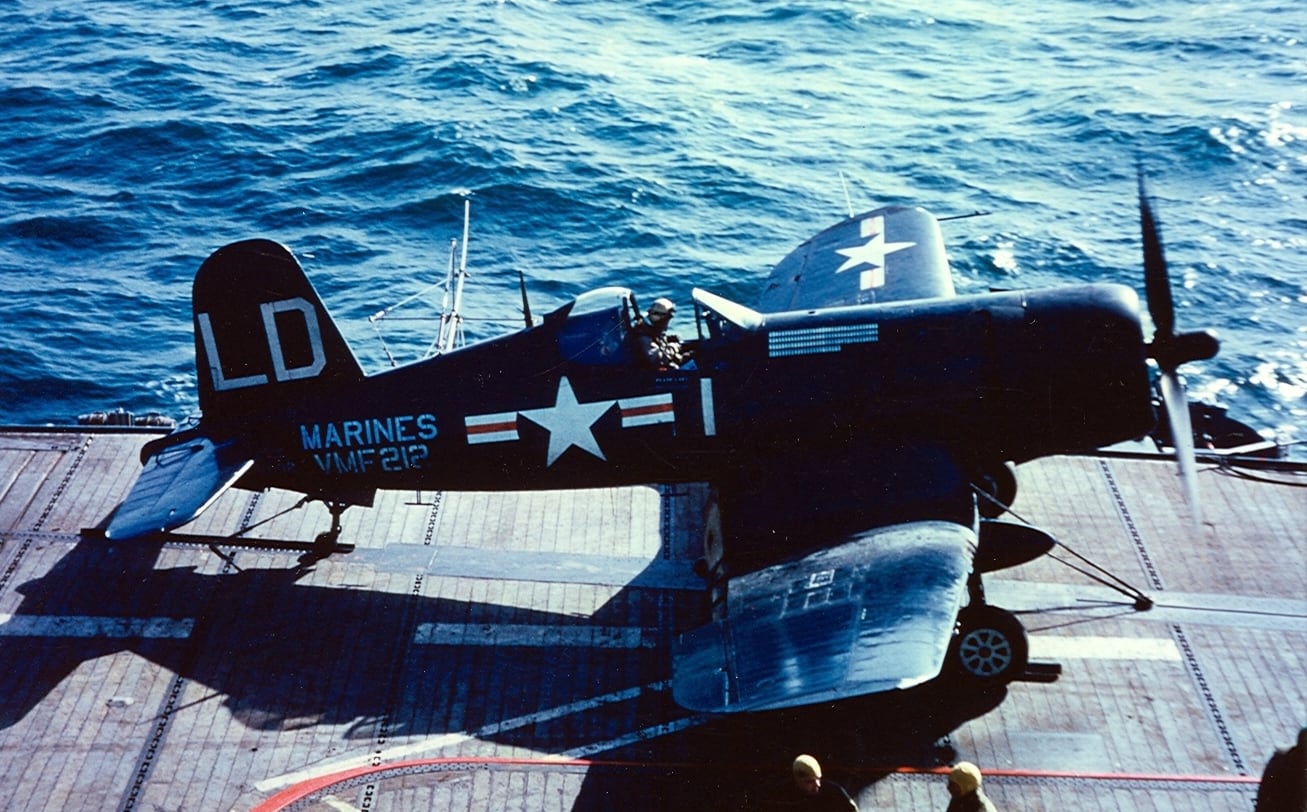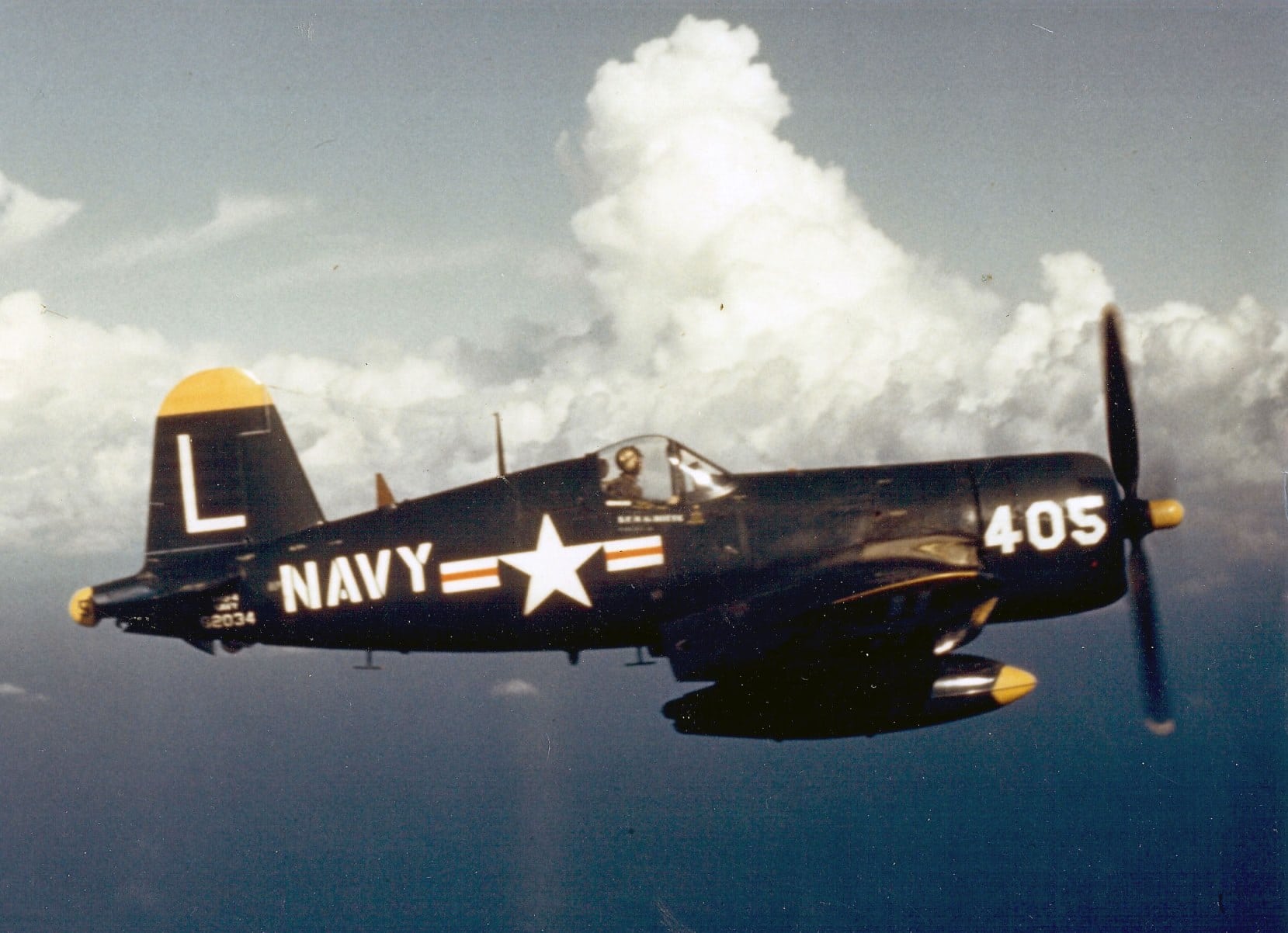Doing the Close Air Support Thing…Again
During the Korean War, the Corsair was used primarily in the close-support role. The AU-1 Corsair was developed from the F4U-5, itself a late war-developed version of the Corsair. As a ground-attack aircraft which normally operated at low altitudes, the AU-1’s Pratt & Whitney R-2800-83W engine used a single-stage, manually controlled supercharger as opposed to the two-stage automatic supercharger of the F4U-5. Corsair versions used by the Marines and Navy in Korea included the F4U-4B, F4U-4C, F4U-4P, F4U-5N, F4U-5NL, and AU-1.

More Than a Ground Pounder
Despite the emphasis on close support and attack missions for the Corsair, there were occasional aerial confrontations. F4Us took on Soviet-built Yakovlev Yak-9 fighters early in the war. Once the MiG-15 jet started showing up, the Corsair was no longer considered capable of taking on the role of fighter aircraft. But on 10 September 1952, one MiG-15 made the mistake of getting low and slow in front of a Corsair piloted by Marine Captain Jesse G. Folmar. Folmar shot the MiG-15 down but was shot down himself by four other MiG-15s soon thereafter. Folmar was rescued and was back in the cockpit the next day.

Getting Theirs at Night
Night-fighting F4U-5N and F4U-5NL Corsairs were used to attack enemy supply lines, truck convoys, and trains. They also did their best to rid the night skies of “Bedcheck Charlies”, the harassing (if not actually dangerous) flights meant to keep the UN troops from resting. Detachments of U.S. Navy F4U-5Ns were often based at shore bases. Lieutenant Guy P. Bordelon of VC-3 Detachment D from the USS Princeton (CV-37) flying from K-6 in South Korea, became the Navy’s only ace of the war and the only ace of the war to fly a propeller-driven aircraft after five aerial victories in the night skies over Korea. Navy and Marine Corsairs were credited with a total of 12 enemy aircraft shot down.

Devotion Personified
Lieutenant Thomas Jerome Hudner Junior, flying an F4U-4 of VF-32 off the USS Leyte, crash landed his Corsair in an attempt to rescue his squadron mate, Ensign Jesse Leroy Brown, whose aircraft had been forced down by antiaircraft fire near Changjin Korea. Brown was the U.S. Navy’s first African-American naval aviator. Hudner was unable to free the wounded Brown from his heavily damaged aircraft and Brown did not survive. Hudner was awarded the Congressional Medal of Honor for his attempt to save his fellow naval aviator.

Service Abroad
Beginning in 1943, the Royal Navy Fleet Air Arm also received Corsairs and flew them successfully from Royal Navy carriers in combat with the British Pacific Fleet and in Norway. These were “clipped-wing” Corsairs, the wingtips shortened 8 inches (20 centimeters) to clear the lower overhead height of the hangar decks on Royal Navy carriers. In addition to its use by the U.S. and the British, the Corsair was also used by the Royal New Zealand Air Force, the French Navy Aéronavale, and other smaller air forces until the 1960s. The Corsair served almost exclusively as a fighter-bomber throughout the Korean War and during the French colonial wars in Indochina and Algeria. Corsairs even squared off against each other during the “Soccer War” between Honduras and El Salvador in 1969.

What’s in a Name?
The infantrymen the Corsair supported so effectively nicknamed the Corsair “The Sweetheart of the Marianas” and “The Angel of Okinawa” for its roles in these campaigns. Among Navy and Marine aviators, the aircraft was nicknamed “Ensign Eliminator” and “Bent-Wing Eliminator” because it required many more hours of flight training to master than other Navy carrier-borne aircraft. It was also called simply “U-bird”, Hosenose”, “The Hog”, or “Bent Wing Bird.”

Record Production Run
Demand for the F4U overwhelmed Vought’s manufacturing capability early in the war. Goodyear and Brewster both built Corsairs in addition to Vought. Goodyear-built Corsairs were designated FG and Brewster-built aircraft were designated F3A. From the first prototype delivery to the U.S. Navy in 1940, to the final delivery of the F4U-7 to the French in 1953, 12,571 F4U Corsairs were manufactured in 16 separate models. This is the longest production run of any piston engine fighter in U.S. History- from 1942 to 1953.
[youtube id=”R4aPk4fledU” width=”800″ height=”454″ position=”left”]

[…] F2A-3 Buffalo. They quickly re-equipped with F4F-4 Wildcats and once they transitioned to the Vought F4U Corsair they flew them for the rest of the war while fighting in the Treasury-Bougainville Campaign, Battle […]
[…] F4U Corsair started service in 1943 as a service primarily based fighter/bomber for the US Navy and Marines. […]
VF-17 actually became carrier qualified in the Corsair before the British. It was decided later to send them ashore, but they could have done the job from the boat as their refueling during the CAP mentioned in your article proved.
As a historical addition, it should be noted that Lindbergh was also a technical advisor to the AAF. He introduced fuel economizing techniques which enabled the P-38s and P-47s to fly long range escort missions accompanying B-24 raids on the oil refineries at Balikpapan, Borneo flying from western New Guinea. Round trip was about 18 hours and some 2,600 miles, mostly over water.